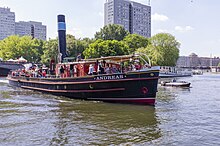Historic port of Berlin

The historic port of Berlin is managed by the Berlin-Brandenburgische-Schiffahrtgesellschaft e. V. (BBSG). The most valuable pieces of large collection are the tugboat Andreas and full steam . There are also a large number of barges , barges and push boats .
In the summer of 1990, shipping enthusiasts from all over Berlin set up the non-profit association Berlin-Brandenburgische Schifffahrtsgesellschaft e.V. on board the steam tug Nordstern . V. to maintain and promote historical inland shipping.
The document from 1298 as the basis for a Berlin "port birthday"
If one wants to derive a written first mention of a port company for Berlin, analogous to the situation in Hamburg , then a certificate sealed by the Brandenburg margrave Otto V (the Langen) as the responsible sovereign dated May 7, 1298 comes into question. In it, the margrave of the city of Berlin confirmed the rights and freedoms, in particular the right of resignation , the Hufen - and Hofstellenzins as well as the city penny and sold her for 220 pounds of Brandenburg coin the wood and ship duty of ships that came to and from Mühlendamm via Fürstenwalde and Köpenick .
The parchment document preserved in the medieval original in the Berlin State Archives has numerous problems. It is external and internal features as well as the date of issue that raised concerns about the authenticity and were already subjected to a comprehensive appraisal by Hermann Krabbo almost 100 years ago. The external features include - despite a fragmentary, authentic impression of Margrave Otto's seal - the writing that points not to the 13th, but to the middle of the 14th century.
The port of Berlin in the Middle Ages
In Berlin, landing sites at the Spree crossing for boats, which soon also carried goods that had to be loaded and unloaded, are likely to have emerged as early as the late 12th century with the first settlers. From the analysis of the customs duties mentioned in the Berlin City Book, which the non-local "guests" had to pay in Berlin, it was already possible in 1880 to extend the privileges of Count Adolf von Holstein (1236/1263), King Wilhelm of Holland for his lands ( 1252) and Countess Margaret of Flanders (1252) closed. This shows that as early as the middle of the 13th century, Berlin was linked to the Elbe estuary and the well-developed Flemish - Dutch area in terms of trade policy .
Current situation

The historic port of Berlin at the Mühlendammschleuse / Fischerinsel has been operated by the Berlin-Brandenburgische Schifffahrtsgesellschaft e. V. revived and operated. In addition, the permanent exhibition shows how closely Berlin's cultural development is linked to inland shipping and the historic port. This is where the first port was built, the twin cities of Cölln - Berlin came into being and from here it was further developed and rebuilt. The goals of the association are:
- Operation of the historic port in the center of Berlin.
- Preservation of the maritime heritage, which is important for the cultural and historical preservation of inland shipping.
- Presentation of the ships to the public and in publications.
- Research into shipping history - especially in the Berlin-Brandenburg area - with the aim of making this accessible to the public.
- Advisory support for private boatmen in the restoration of their historic inland vessels.
- To enable young people and other interested parties to work in the operation and maintenance of traditional watercraft, as well as to provide insights into the skills that are part of the historical occupational profile of inland navigation.
Future prospects
The port with its ships offers a unique space for encounter and community thanks to the merging of technology, art, culture and nature in the city. With the proximity to the Märkisches Museum and an adventure trail with art in public space currently being planned by the Historic Harbor, an important cultural educational mission is fulfilled at the beginning of the Museum Island.
In the Historic Harbor, nature and the environment are viewed as a valuable ecosystem that needs to be treated with care . Not only for people, but also for the remarkably diverse water bird world in the center of Berlin. The development of this ecosystem is being further expanded with the strong commitment of the volunteer "dock workers".
Coupled with the conservation of chestnuts and the greening of barges, the historic port of Berlin strives for CO 2 neutrality.
Web links
Coordinates: 52 ° 30 ′ 49 ″ N , 13 ° 24 ′ 43 ″ E